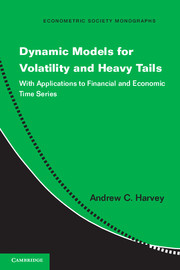 Dynamic Models for Volatility and Heavy Tails
Dynamic Models for Volatility and Heavy Tails Book contents
- Frontmatter
- Contents
- Preface
- Acronyms and Abbreviations
- 1 Introduction
- 2 Statistical Distributions and Asymptotic Theory
- 3 Location
- 4 Scale
- 5 Location/Scale Models for Non-negative Variables
- 6 Dynamic Kernel Density Estimation and Time-Varying Quantiles
- 7 Multivariate Models, Correlation and Association
- 8 Conclusions and Further Directions
- A Derivation of Formulae in the Information Matrix
- B Autocorrelation Functions
- C GED Information Matrix
- D The Order of GARCH Models
- E Computer Programs
- Bibliography
- Author Index
- Subject Index
- Other titles in the series
6 - Dynamic Kernel Density Estimation and Time-Varying Quantiles
Published online by Cambridge University Press: 05 May 2013
- Frontmatter
- Contents
- Preface
- Acronyms and Abbreviations
- 1 Introduction
- 2 Statistical Distributions and Asymptotic Theory
- 3 Location
- 4 Scale
- 5 Location/Scale Models for Non-negative Variables
- 6 Dynamic Kernel Density Estimation and Time-Varying Quantiles
- 7 Multivariate Models, Correlation and Association
- 8 Conclusions and Further Directions
- A Derivation of Formulae in the Information Matrix
- B Autocorrelation Functions
- C GED Information Matrix
- D The Order of GARCH Models
- E Computer Programs
- Bibliography
- Author Index
- Subject Index
- Other titles in the series
Summary
A GARCH filter weights squared observations to produce a measure of variance, but variance is of limited utility when the conditional distribution is not Gaussian. Letting the score drive the dynamics reflects the full conditional distribution, and this was the approach adopted for the models described in Chapters 3, 4 and 5. However, if a parametric model is felt to be too restrictive, the question arises regarding whether a distribution-free filter is possible.
When observations are independent, a probability density function, or the corresponding cumulative distribution function, may be estimated nonparametrically by using a kernel. There is an enormous literature on this topic, but relatively little has been written on applying kernel estimation to time series; see, for example, Markovich (2007). However, if the distribution is thought to change over time, observations may be weighted by adapting the filters described in the preceding chapters. Not only can updating be carried out recursively, but a likelihood function can be constructed from the predictive distributions, as in an observation-driven model. Hence dynamic parameters may be estimated by maximum likelihood. Furthermore, the dynamic specification may be checked using the residuals given by the predictive cumulative distribution function. The methods are those appropriate for the probability integral transform.
- Type
- Chapter
- Information
- Dynamic Models for Volatility and Heavy TailsWith Applications to Financial and Economic Time Series, pp. 187 - 203Publisher: Cambridge University PressPrint publication year: 2013
